Being stealthy and sneaky helps prey evade predators and predators to catch their prey. Many animals have sneaky adaptations that help them throughout their life. From camouflage to ambush hunts, these animals have it all figured out.
Here are some of the sneakiest animals in the world today!
Fox
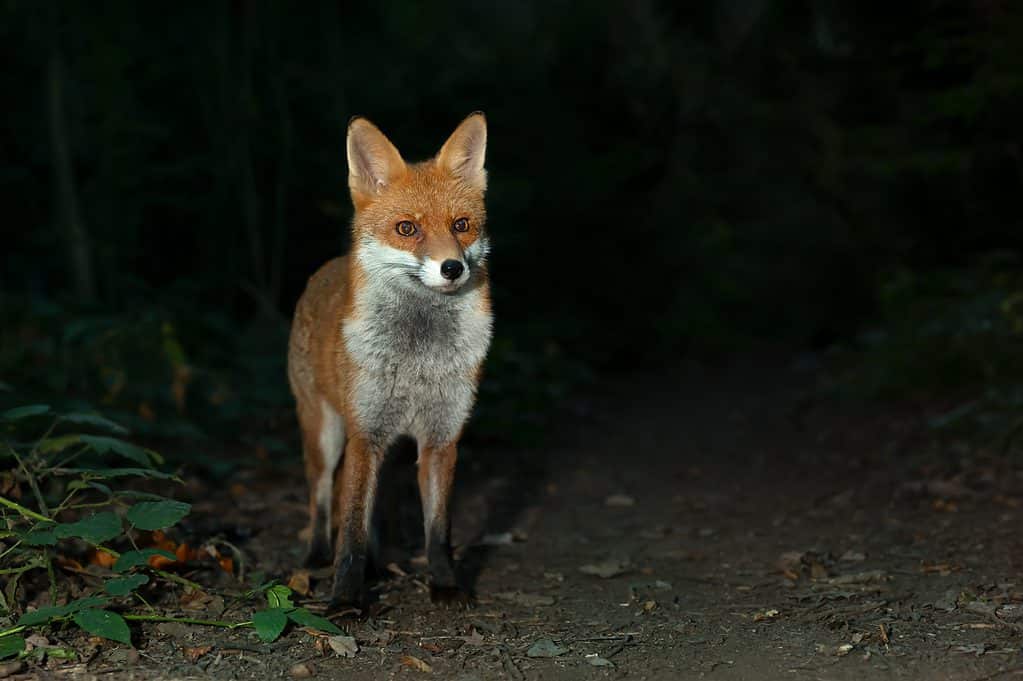
A red fox at night in the United Kingdom.
©Giedriius/Shutterstock.com
Foxes are such sneaky animals that the saying “sly as a fox” has been associated with them. They are small, agile, and can move quietly when hunting. While they live in small families called “skulks,” foxes are lone hunters and travel alone, making it easier for them to remain undetected.
Foxes are mostly active at night, which aids them in their stealth. They use their keen sense of sight to see in low-light environments and hunt their prey. Although they are a member of the same family as wolves, jackals, and dogs, foxes have a unique characteristic: they have semi-retractable claws that allow them to climb trees, making them even sneakier! They are often seen sleeping on the branches of the trees.
Foxes can run up to 42 miles per hour and jump up to three feet in the air. This allows them to traverse most obstacles. Due to their speed and climbing abilities, they can scramble over a six-foot-high fence if needed.
Sneakiest Animals: Cat

Cats are natural-born hunters.
©Shebeko/Shutterstock.com
If you own a domestic cat, you know they can be very sneaky. Built into their nature, they have an instinctual drive to be on the prowl and sneak around to avoid detection. Cats use their skills to distribute weight evenly across all four legs, allowing them to move through any environment without making much noise. Combined with their tendency to keep themselves as low to the ground as possible, cats are sneaky.
Cats are natural-born hunters, just like their distant big-cat relatives. Humans originally desired these small felines for this exact reason. They were domesticated to catch small rodents that were pests to humans, and they retain this characteristic even today.
Cats are very agile and can jump straight up into the air up to six times their height. They also have an amazing ability to stabilize themselves during a fall and can survive drops of up to 200 feet without injury!
On average, a cat can reach a top speed of 30 miles per hour which they use to avoid predators or catch their prey. An interesting fact is that the average reaction time of a cat is between 20 and 70 milliseconds. Comparing this to the average snake’s reaction time of between 44 and 70 milliseconds, the cat can easily swipe away a striking snake.
Black Mamba
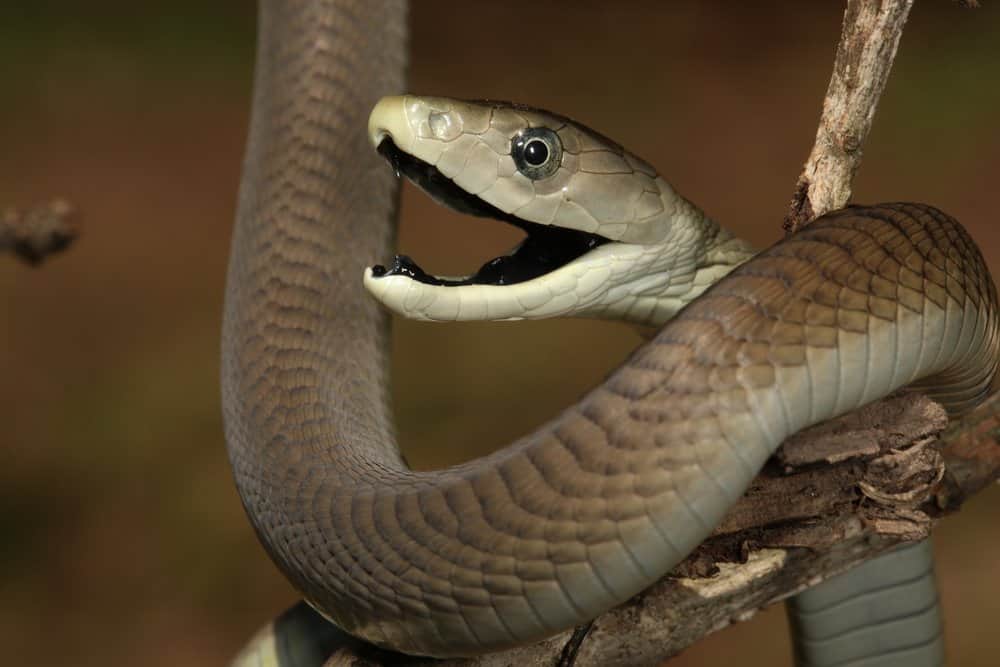
Unlike most other snake species, black mambas use their eyesight to be aware of their surroundings.
©NickEvansKZN/Shutterstock.com
Black mambas are reclusive reptiles but become very aggressive if provoked. Because they tend to hide, they are very sneaky animals. Unlike most other snake species, black mambas use their eyesight to be aware of their surroundings. Instead of using just their sense of smell or heat, black mambas can see their prey much sooner than other snakes.
These snakes use their dark coloring to blend into their surroundings, making it very difficult to detect them while they are lying motionless. They like to hide amongst leafy debris on the ground but are also known to head upwards into the trees.
Black mambas will actively hunt for food during the daytime, using their sight and intelligence to find prey. They can move at speeds around 7 miles per hour or bursts of up to 12.5 miles per hour. The average speed a human can run over a distance is only around 6 miles per hour – compared to those speeds, these snakes are fast! You will unlikely be able to outrun an attacking black mamba. In fact, they have been known to chase people down to attack them.
Sneakiest Animals: Octopus

These adaptable species can camouflage themselves and even change the texture of their bodies to match their surroundings.
©Olga Visavi/Shutterstock.com
Octopuses are soft-bodied mollusks that use their unique bodies to be extremely sneaky. Their sneakiness comes from their incredibly soft body that can alter their shape like you wouldn’t believe. Their bodies are amazing, and these beautiful creatures are intelligent with excellent eyesight! All of these things help the octopus to be even sneakier.
These amazing creatures live in the ocean, in coral reefs, seabeds, and extremely deep depths. These adaptable species can camouflage themselves and even change the texture of their bodies to match their surroundings. These masters of camouflage help them escape from their predators, such as fish, seabirds, and sea otters. Another sneaky way these creatures evade becoming prey is by ejecting an ink cloud which distracts the predators. Some octopuses can even perform arm autonomy when they are under attack!
Adult octopuses’ diet consists of crabs, clams, snails, and small fish. Because of their excellent eyesight, these creatures can spot their prey even in dark conditions. Some will use their arms to explore cracks and crevices and wrap around any prey they can find. Once the prey is found, octopuses deliver venom through its beak, which helps break down the prey’s flesh. Their sneakiness helps them to be great predators and helps them to evade predators of their own.
Weasel
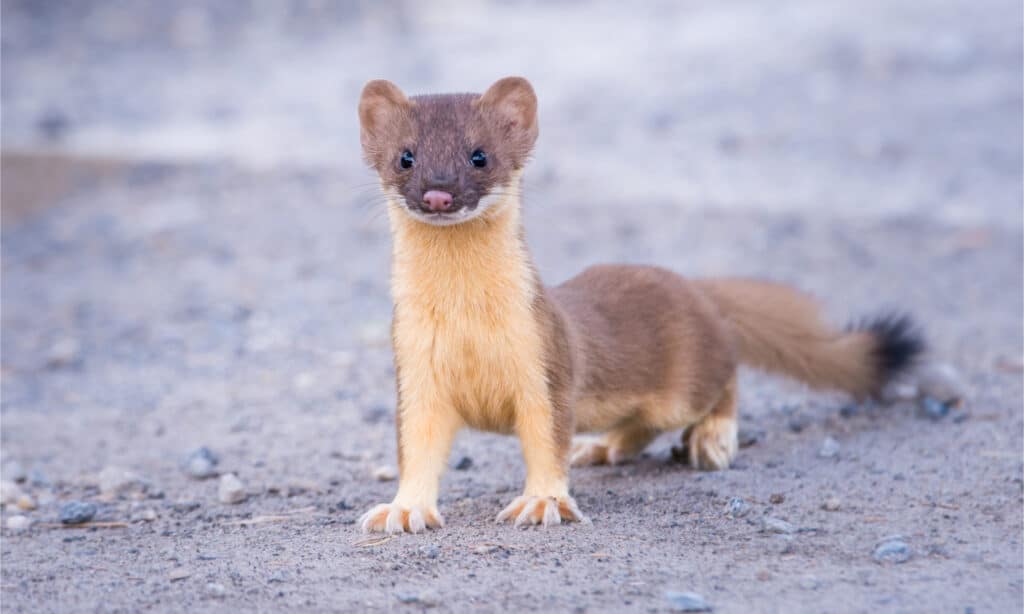
Although cute and small creatures, weasels are fierce and can kill prey up to 10 times their body weight.
©Ghost Bear/Shutterstock.com
Weasels are well known for being sneaky, conniving, and untrustworthy. They have long slender bodies and small feet, making them masters of stealth. Weasels can move at rapid speeds and are very agile. They can leap high into the air and across long distances, making these creatures incredibly difficult to catch. Weasels choose to stay close to cover as they move and will avoid large exposed and open areas to avoid being seen by predators.
Although cute and small creatures, weasels are fierce and can kill prey up to 10 times their body weight. They use their long bodies to ensnare their prey, and once it is caught, it will deliver a devastating bite to the back of its head, killing it quickly.
Weasels have a fascinating characteristic of dancing before they attack. They are thought to hop and jump around to distract and confuse their prey. They can also spray an oily yellow liquid at threats, similar to skunks.
Sneakiest Animals: Cheetah
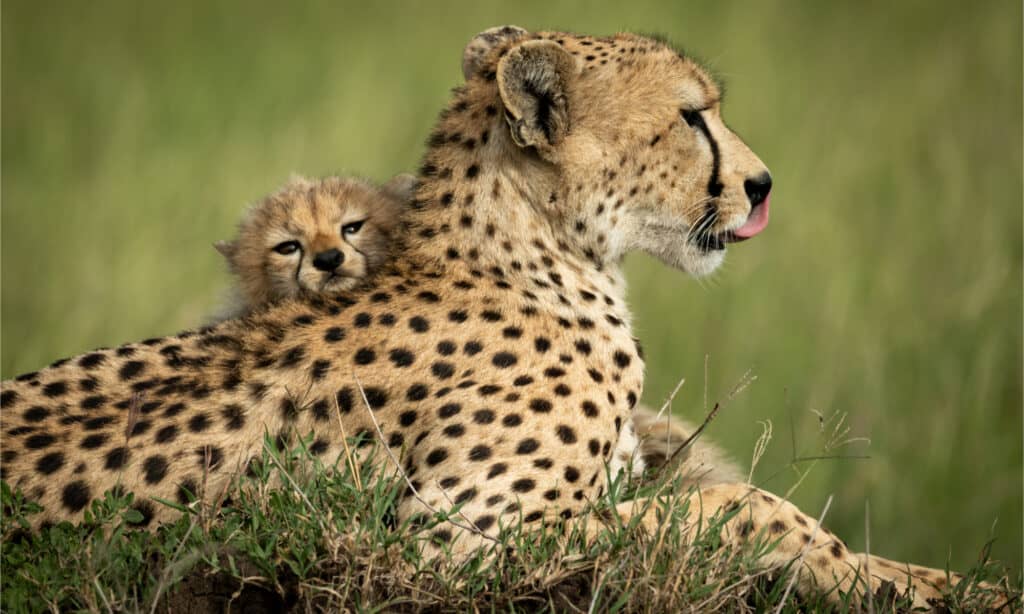
Even though cheetahs are great predators, some animals also prey on them.
©nwdph/Shutterstock.com
Cheetahs are sneaky and stealthy predators. These large felines need to get close to their prey before pouncing, so being sneaky is a must. Even though cheetahs are fast, they do not have the stamina to run for long periods. Using their stealth, these animals can save energy and become more successful in catching their prey.
Cheetahs are native to Africa and Southwest Asia and typically inhabit savannahs, arid mountain ranges, and hilly desert terrain. The cheetah’s coat helps these cats blend into their surroundings. They are typically tawny and covered with solid black spots.
The primary prey of the cheetah is medium-sized ungulates such as small antelope, impala, and gazelles. Even though cheetahs are great predators, some animals also prey on them. Lions, leopards, and hyenas may try to prey on cheetahs. Yet due to their incredible speed, they are difficult to catch.
Chameleon
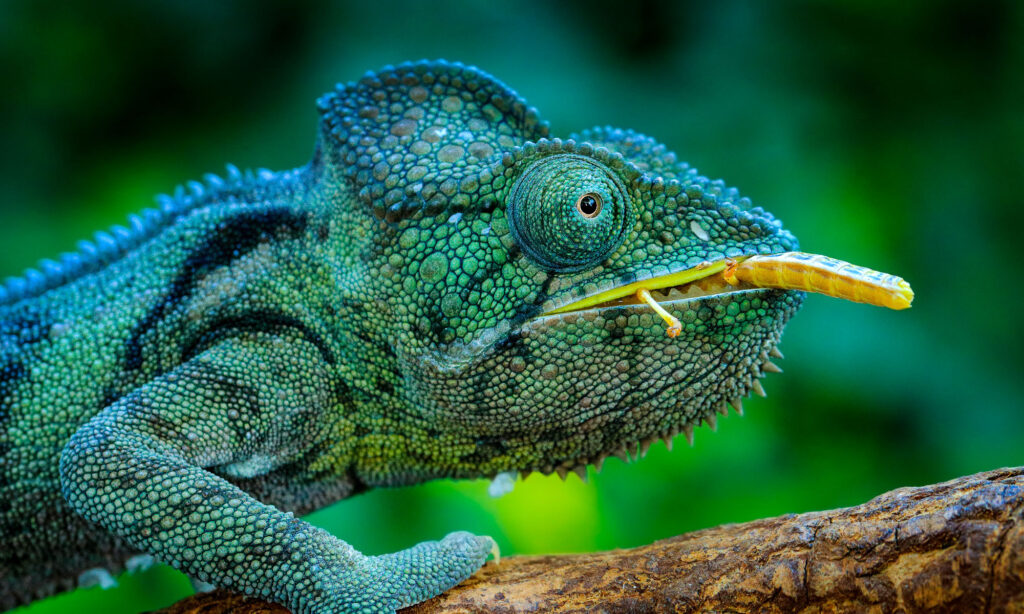
They will also use their color-changing skills to attract mates, regulate their body temperature, and deter potential predators.
©Ondrej Prosicky/Shutterstock.com
These incredible reptiles have mastered the skill of stealth and can change the color of their skin to match their surroundings. They have large opposing toes that help them climb through trees with ease. They perch themselves in perfect hiding spots. These reptiles will also use their color-changing skills to attract mates, regulate their body temperature, and deter potential predators.
A chameleon’s tongue is an impressive length, up to two times its body length, and can be projected from its mouth from 0 to 60 miles per hour in only a hundredth of a second! Their tongues are covered in an incredibly sticky substance that helps them catch their prey from a seemingly unthreatening distance. Their diet includes insects, crickets, and dragonflies, so stealth is important for them to be able to get close enough to strike without the prey feeling threatened.
Although they are expert hiders, they are also great runners. They can travel at speeds of up to 21 miles per hour to catch prey or avoid predators!
Sneakiest Animals: Alligator Gar
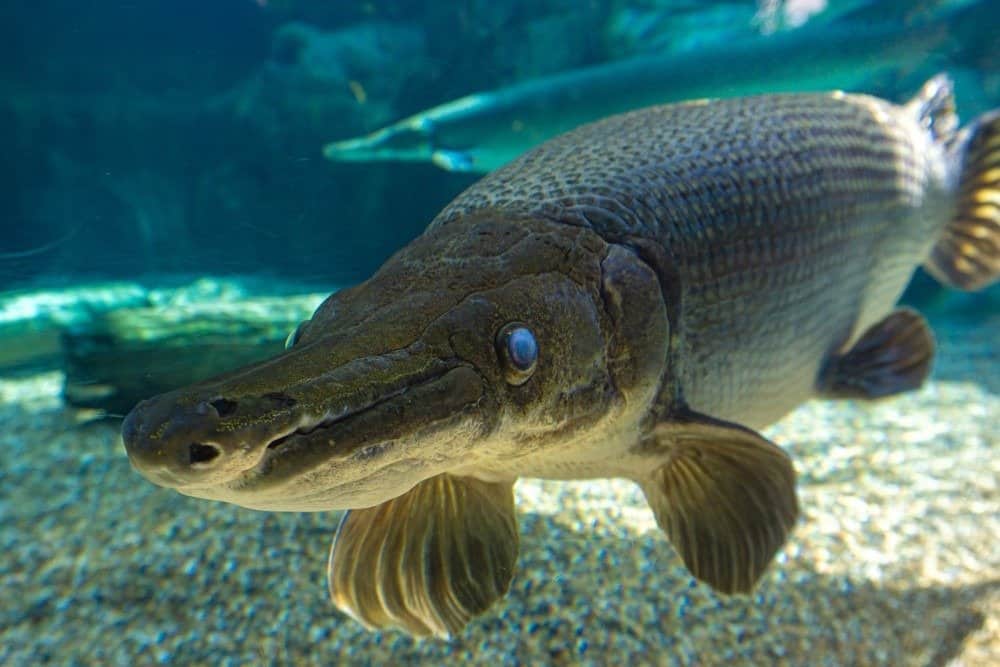
The
alligator
gar (Atractosteus spatula) is a ray-finned euryhaline fish related to the bowfin.
©TKBackyard/Shutterstock.com
The alligator gar is a freshwater fish found in North America. The animal gets its name from its resemblance to the American alligator. The broad snouts and long, sharp teeth definitely make these fish intimidating. Although they seem sluggish, the alligator gar is considered sneaky as it is an ambush predator. In fact, they can catch prey such as waterfowl, turtles, fish, and small mammals that float on the surface.
Their sneaky ambush attacks are executed by floating a few feet below the surface of the water. There, they will wait for prey to swim within reach. Once the prey is in reach, these fish will lunge, grab their prey, and impale it with their sharp teeth.
The alligator gar is a large fish that you would think would be easily detected. These masters of ambush can measure around 6 feet in length and over 100 lbs in weight! The alligator gar relies on their stealthiness and sneakiness to be able to feed – a truly sneaky animal!
Owl
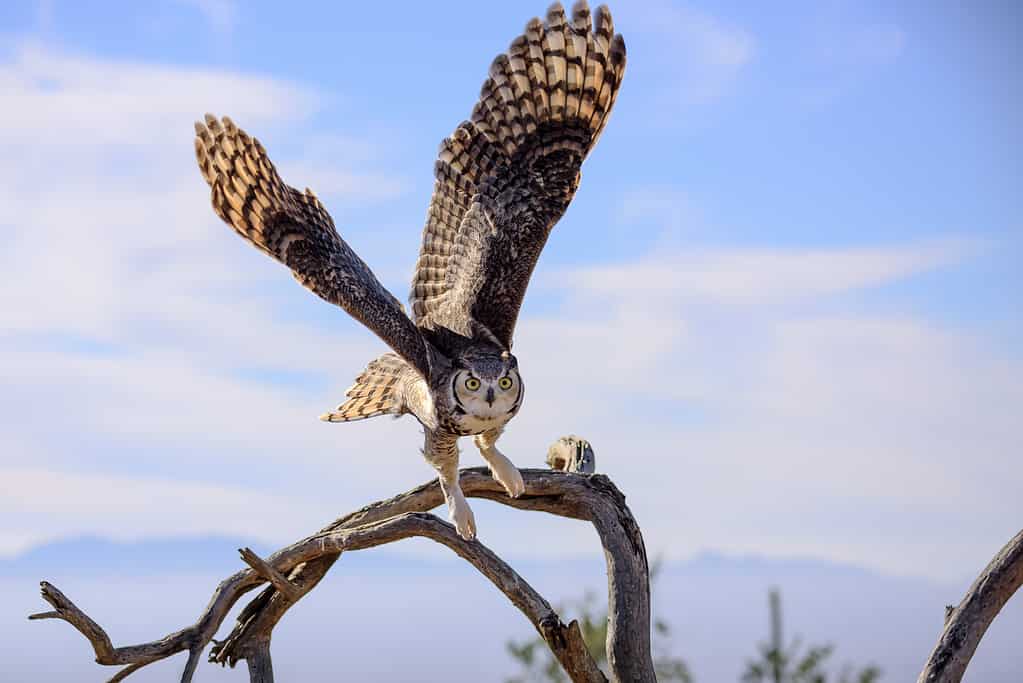
The great horned owl has the largest wingspan of any North American owl.
©iStock.com/kojihirano
Owls are carnivorous birds that rely on stealth and surprise to catch their prey. Owls are nocturnal, and they hunt in the dark. To achieve stealth, these birds have a dull feather coloration. This means that they are basically invisible in certain conditions! Another adaptation these birds have to achieve stealth is the serrated edges on the owl’s flight feathers that muffle wing beats. This allows an owl’s flight to be silent.
Owls hunt many things, including small mammals, insects, and even other birds. Their stealthiness is key to being successful hunters. Additionally, these birds have terrific eyesight and hearing—the best of any animal ever tested. By using their incredible senses, these birds can locate their prey from far distances!
Once the owl has found its prey, it will use its talons to snatch, squeeze, and kill the prey. Owls also use their talons to defend themselves from predators, including hawks, raccoons, and other owls. They also have a strong beak that can be used to defend and tear apart their prey.
Frogfish
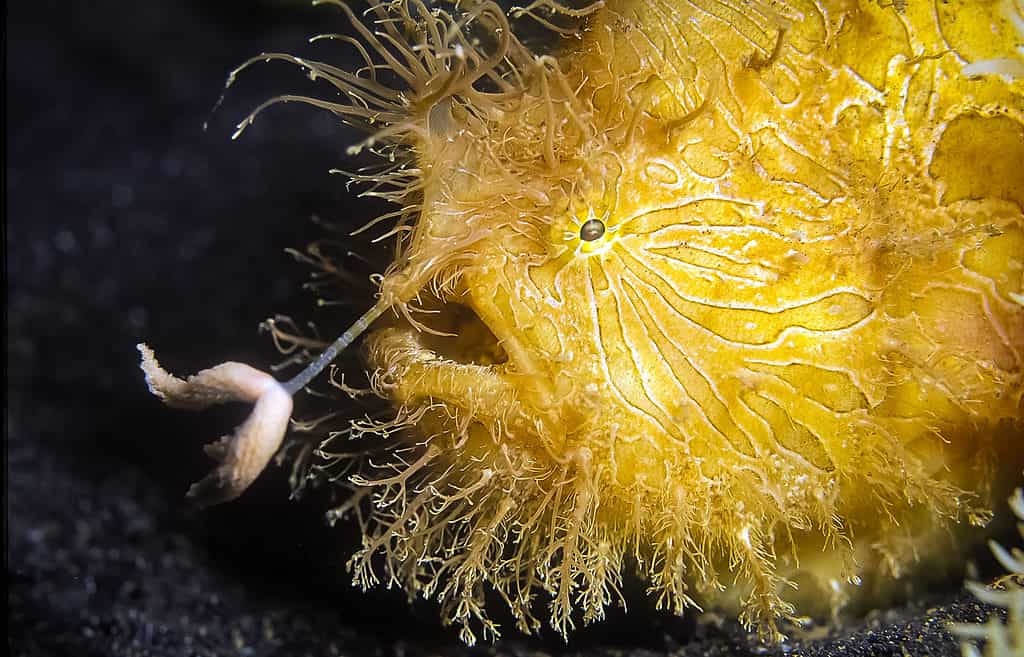
Yellow hairy
frogfish
(
Antennarius striatus).
©Jack FotoVerse/Shutterstock.com
Frogfish are adept at disguising themselves in their ocean environment. Each species of frogfish has evolved different camouflage types to suit its surroundings; some resemble the texture and color of sea sponges, while others have long waving extremities that can look like algae. One species can even change its coloring to help it blend in with red, pink, brown, or yellow rocks and sponges. Frogfish are solitary animals and prefer to live alone instead of in groups. They are territorial animals and often fight to defend their space against other frogfish or intruders.
Frogfish belong to the angler family and use a lure that dangles from their heads to attract prey. The seemingly harmless worm-like lure looks like a tasty treat to small fish and crustaceans. The frogfish will catch and eat when the unsuspecting prey comes close enough. Their prey includes crustaceans, small fish, and even other frogfish.
To get around on the ocean floor, the frogfish uses its specialized pectoral fins, which act like legs. They can walk around instead of swimming, which adds to their stealth levels. They move slowly and carefully to sneak up and ambush their food.
Sneakiest Animals: Leaf-Tailed Gecko

The leaf-tailed gecko appears as a dead leaf.
©Jiri Balek/Shutterstock.com
Masters of mimicry and camouflage, leaf-tailed geckos are very hard to spot in their natural habitat. They have long, flat bodies covered with green skin with black patterns, resembling the forest floor. Leaf-tailed geckos have an incredible feature where they use flaps of skin on the sides of their bodies to stretch out and disguise the shape of their bodies – this allows them to blend into their surroundings completely. Another distinguishing feature of these geckos is a broad tail in the shape of a leaf. Their sneakiness is on another level!
Although they are very sneaky while undisturbed, the leaf-tailed gecko has a powerful distress call they use when they feel threatened. They open their jaws wide, exposing their bright red mouths, and scream, which resembles the scream of a small child.
Leaf-tailed geckos are nocturnal and come out at night to hunt for their prey. Their prey includes crickets, snails, flies, and moths. Some species have even been spotted feasting on spiders and centipedes! They use their large eyes that have excellent night vision and a keen sense of smell to locate their prey.
Tarantula

Purple tarantulas are native to Ecuador in South America.
©Lukasz Kowalkowski/Shutterstock.com
Tarantulas are large, hairy spiders that hunt by ambush. These sneaky spiders don’t spin webs to trap prey. Instead, they leave their burrows and hunt. These spiders are nocturnal hunters. They feed on insects, other spiders, and arthropods. Some will even eat small rodents, birds, and snakes! These spiders usually measure 5 inches in length and mostly eat prey smaller in size than they are.
Tarantulas rely on vibrations from the ground that signal where to hunt for prey. Their extreme sensitivity to vibrations makes these hunters great at finding their prey. Tarantulas use stealth to ambush their prey and catch them by biting them. The fangs, or chelicerae, release a venom that paralyzes their prey. The venom also dissolves the prey’s meat and liquefies the flesh. The tarantula then sucks out the liquid using its straw-shaped mouth.
Sneakiest Animals: Orchid Mantis
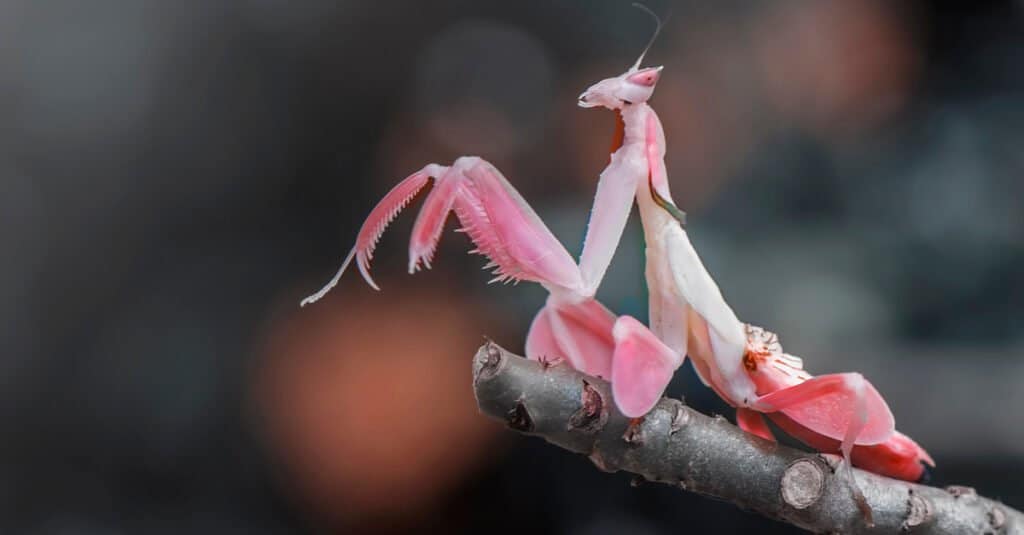
The orchid mantis mimics both the colors and petal structure of an orchid.
©Galuh M/Shutterstock.com
The orchid mantis is found in tropical forests of Southeast Asia. These sneaky creatures use their bodies as disguises as a flower to capture unsuspecting prey. Once the prey is near them, the orchid mantis will grab the prey at an incredible speed. The diet of the orchid mantis includes small insects such as flies, beetles, and bees.
The orchid mantis is pink and white with flattened limbs resembling flower petals. The mantis will climb up a plant with flowers and holds onto it with their claws. They will then sway from side to side. Insects are attracted to the orchid mantis primarily because of the black spot on its abdomen which resembles a fly.
The mimicry of the orchid mantis is outstanding. By impersonating flowers, these insects are extremely successful hunters. The camouflage also helps deceive possible predators – how sneakier can these insects get?
Crocodile
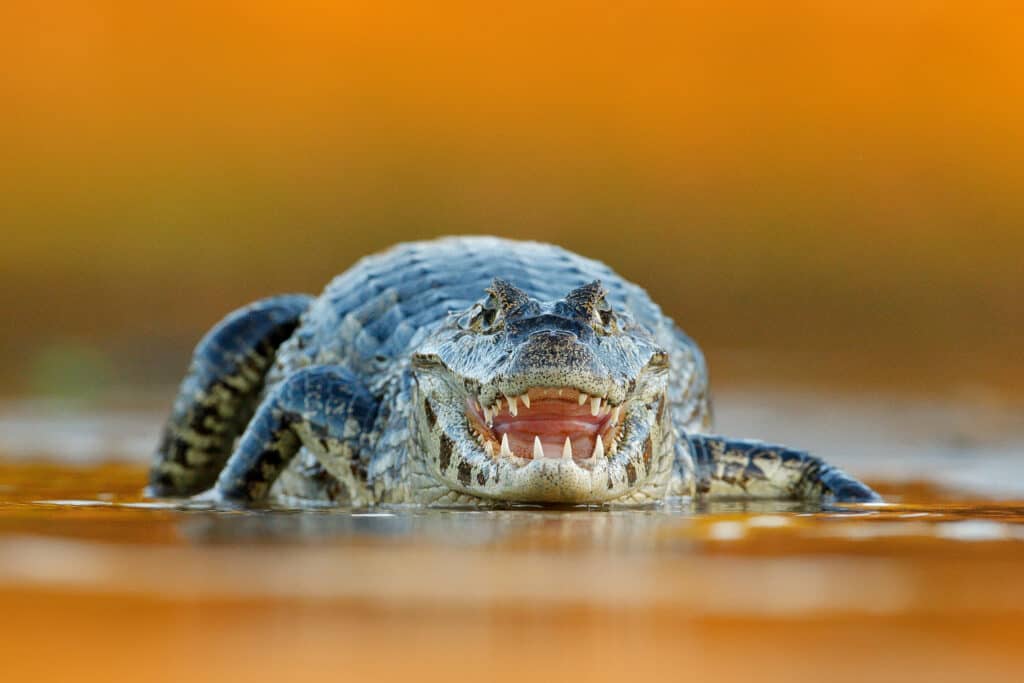
The Yacare caiman is endemic to Argentina, Bolivia, Brazil, and Paraguay.
©Ondrej Prosicky/Shutterstock.com
Crocodiles are large reptiles that live in Africa, Asia, the Americas, and Australia. Their sneakiness is found in how they hunt – by ambushing prey. Even though some species of crocodiles can grow to around 17 feet long and weigh over 2,000 lbs, they somehow manage to catch unsuspecting prey.
Crocodiles are semi-aquatic and can swim with speed or run on land. Their streamlined body, webbed feet, and strong tail help them to be great swimmers. The most noticeable part of the crocodile is its teeth. These creatures have 80 teeth that can be replaced up to 50 times during their life! No wonder these creatures are fearless predators.
Crocodiles are ambush predators and wait for fish or land animals to come close to them before attacking. Their diet consists of fish, amphibians, birds, reptiles, and mammals. Some will even eat smaller crocodiles! These ferocious predators may seem slow, but they have a swift strike, making them successful predators. Their sharp teeth and exceptional bite force ensure their prey does not escape. These big reptiles really use their stealth and sneakiness to their highest advantage.
The photo featured at the top of this post is © Galuh M/Shutterstock.com
Thank you for reading! Have some feedback for us? Contact the AZ Animals editorial team.






